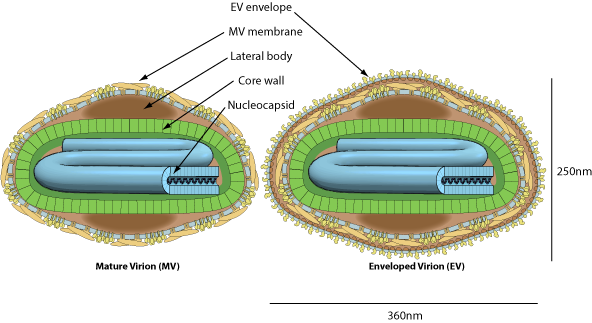Cervidpoxvirus (taxid:573055)
VIRION

Enveloped, brick-shaped , 300x270x200nm. The surface membrane displays surface tubules or surface filaments. Two distinct infectious virus particles exists: the intracellular mature virus (IMV) and the extracellular enveloped virus (EEV).
GENOME
Linear, dsDNA genome of about 154kb. The linear genome is flanked by inverted terminal repeat (ITR) sequences which are covalently-closed at their extremities.
GENE EXPRESSION
ENZYMES
- DNA-directed DNA polymerase
- DNA-directed RNA polymerase
- Cell-type capping
- Core protease (Peptidase C57)
REPLICATION
CYTOPLASMIC
- Attachment of the viral proteins to host glycosaminoglycans (GAGs) mediates endocytosis of the virus into the host cell.
- Fusion with the plasma membrane to release the core into the host cytoplasm.
- Early phase: early genes are transcribed in the cytoplasm by viral RNA polymerase. Early expression begins at 30 minutes post-infection.
- Core is completely uncoated as early expression ends, viral genome is now free in the cytoplasm.
- Intermediate phase: Intermediate genes are expressed, triggering genomic DNA replication at approximately 100 minutes post-infection.
- Late phase: Late genes are expressed from 140 min to 48 hours post-infection, producing all structural proteins.
- Assembly of progeny virions starts in cytoplasmic viral factories, producing an spherical immature particle. This virus particle matures into brick-shaped intracellular mature virion (IMV).
- IMV virion can be released upon cell lysis, or can acquire a second double membrane from trans-Golgi and bud as external enveloped virion (EEV).
Host-virus interaction
Apoptosis modulation
Deerpox virus encodes an inhibitor of apoptosis DPV022 that regulates host Bak and Bax
 .
.
Matching UniProtKB/Swiss-Prot entries
(all links/actions below point to uniprot.org website)3 entries grouped by strain
2 entries
Deerpox virus (strain Mule deer/United States/W-848-83/1983) (DPV) reference strain
1 entry
